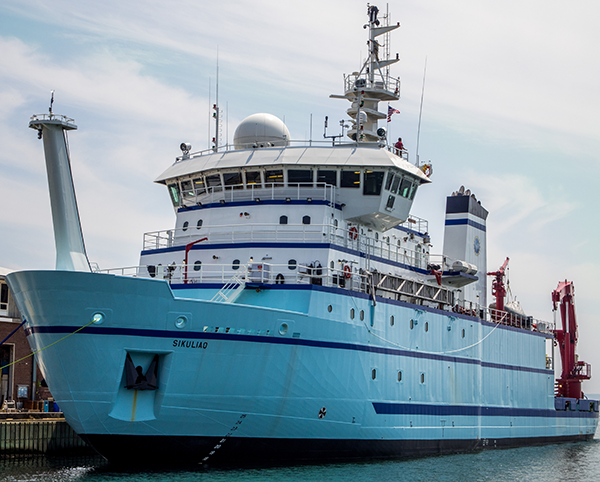On the Ice Edge
Researchers head to the Arctic Ocean to study the fall ice advance and interactions between the atmosphere, ocean, and waves on sea ice formation
This month, Ola Persson and Byron Blomquist, CIRES researchers who work at ESRL’s Physical Sciences Laboratory (PSL), are aboard the NSF icebreaker ship, the R/V Sikuliaq. The Sikuliaq is heading to the Arctic Ocean and the edge of the sea-ice to follow the seasonal ice growth as it advances southward. Persson and Blomquist are part of a team measuring processes involved in ice growth, ice movement, wave conditions and impact, and the interplay between the atmosphere, sea-ice, and the ocean. These systems can influence weather and climate around the world, so better understanding these processes can lead to improved forecasts.
At this time of year, heat is lost over open water areas and heat coming into the atmosphere may impact the jet stream and conditions at midlatitudes. For the six-week long Sea State cruise—a large international project sponsored by the Office of Naval Research— PSL has joined with the Naval Postgraduate School (NPS) to deploy equipment that will measure the surface energy and its fluctuations over open water and in the marginal ice zone in the western Arctic Ocean. To collect these observations, PSL has installed a suite of instruments on the bow of the ship, including a flux tower, sonic anemometers, and radiometers.
“This is the first deployment of our new Arctic-hardened seagoing flux system, which has been under development for several years,” says NOAA physicist and Sea State project lead Chris Fairall of PSL.
NPS is providing atmospheric sounding weather balloons, which are being released several times a day, based on the conditions.
Using new highly-sensitive atmospheric pressure sensors and a wave-mapping lidar, the PSL scientists are also attempting to take the first-ever ship-based direct measurements of atmospheric winds in conjunction with ocean waves and sea-ice.
“This is something no one has ever been able to measure before,” says Persson. “The information will help improve our understanding of how waves impact the near-surface atmosphere AND how the near-surface atmosphere impacts the waves.”
Concurrently, PSL will also be evaluating its new experimental sea ice forecasting model. The purpose of this coupled model is to understand the atmospheric, oceanic, and sea-ice processes that impact formation. A modified version of the NCAR Community Earth System Model, the experimental PSL version includes atmospheric, oceanic, ice/land surface components run at a high resolution (10km). PSL researchers in Boulder are providing daily, 5-day forecasts to the Sikuliaq and use shipboard observations to validate the model output.
The Sikuliaq departed Nome, Alaska in early October and returns November 10th to Dutch Harbor, Alaska.
Posted: October 14, 2015
CIRES is a partnership between NOAA and the University of Colorado


Follow Persson and Blomquist’s Blog at CIRES